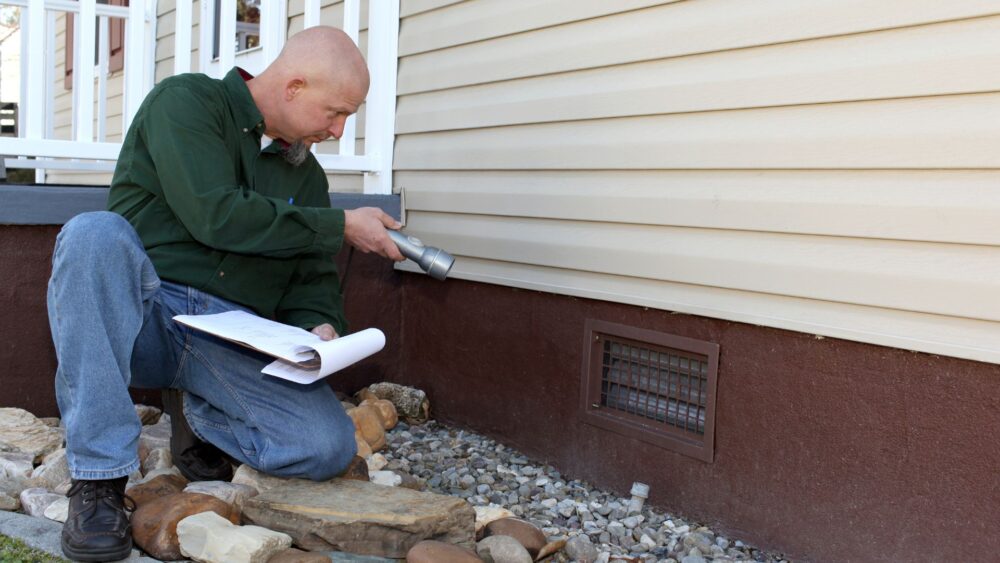Imagine a house without its foundation. Now, shake that image out of your head because it’s virtually impossible. A home stands strong on its very backbone: the **home foundation maintenance**. But let’s face it, most homeowners have danced around this topic like it’s a hot potato.
Maintaining your home’s foundation might not be what you dream about at night, but neglecting it can turn into an actual nightmare—think cracks wider than the Grand Canyon and repair costs that could rival a small fortune.
The truth is as solid as concrete: keeping up with foundation maintenance can prevent catastrophic damage to your entire structure. Did you know? Simply using an automatic lawn sprinkler in warmer months or ensuring proper drainage could save you from breaking the bank on repairs later down the line.
This isn’t just about avoiding financial distress; it’s about preserving peace of mind by knowing your sanctuary stands firm against nature’s whims. So yes, while checking for hairline cracks or monitoring moisture levels might not sound thrilling, they are essential steps in safeguarding the place you call home. Taking these precautions helps ensure that when storms hit, you’re ready to face them head-on without worry.
10 Essential Foundation Maintenance Tips for Homeowners
Protecting your foundation is important. Without a proper foundation, your home could experience serious structural issues and eventually begin to crumble down. Because of this, proper foundation maintenance is crucial.
Regular maintenance will not only keep serious foundation issues at bay, but it will also help keep repair costs low. This article will help you learn some good ways to properly maintain your home’s foundation.
Check out the following foundation maintenance tips to guide you through the proper maintenance of your home’s foundation.
Keep the Ground Moist
Make sure your foundation soil never becomes exceedingly wet or dry. So, when the soil around your foundation expands and shrinks back, it can lead to some pretty troublesome cracks. Simply use an automatic lawn sprinkler to moisten the soil around your structure in warmer months.
Monitor and Manage Drainage
Make sure that the soil around your foundation is properly graded. Water should flow away from the foundation, not towards it. This can be achieved by ensuring the ground slopes away from the foundation. Additionally, ensure that your gutters and downspouts are in good working order and direct water away from the foundation. Water can cause severe damage to foundations if not correctly managed.
Repair Known Plumbing Issues
Annual plumbing tests are critical to maintaining your foundation. It is essential to check for leaks, water pressure, and water flow to ensure your plumbing system functions correctly. A plumbing leak can cause significant damage to your foundation, and early detection can save you from expensive repairs.
Watch Out for Tree Roots
Another foundation maintenance tip is to avoid planting trees or shrubs too close to the foundation. The roots of these plants can grow and cause structural damage to the foundation.
Signs of Foundation Damage to Watch For
One of the most important foundation maintenance tips is to keep an eye out for any signs of foundation damage, such as cracks in the walls, sloping floors, shifted door frames, and sticking windows. All these signs are telling you it’s probably time to give your foundation some love and care.
Cracks in Walls and Floors
Cracks in walls and floors are one of the most common signs of foundation damage. These cracks can be hairline or larger, and they may appear in a variety of patterns. If you notice any cracks in your walls or floors, it’s important to have them inspected by a professional as soon as possible.
Insects in or Around the Foundation
It pays to walk around your foundation every couple of months (particularly in the summer months) and check for any indications of foundation issues. Trailing insects can hasten foundation deterioration so it’s important to fill any holes or hairline cracks you see. If you have a pier and beam foundation, check the crawlspace for signs of moisture, mildew and wood rot.
Maintaining Proper Moisture Levels Around Your Foundation
Make sure your foundation soil never becomes exceedingly wet or dry. So, when the soil around your foundation expands and shrinks back, it can lead to some pretty troublesome cracks. Simply use an automatic lawn sprinkler to moisten the soil around your structure in warmer months.
Water Deeply and Infrequently
When watering your foundation, it’s important to water deeply and infrequently. This means watering for longer periods of time, but less often. This allows the water to penetrate deep into the soil, which helps to maintain a consistent moisture level around your foundation.
Adjust Watering Schedule Based on Weather
Temperature swings are a big reason why cracks and damage show up in slab foundations. Therefore, keeping your home or business temperature consistent year-round is critical to prevent materials such as concrete, drywall, and wood from contracting and expanding.
The Role of Proper Drainage in Foundation Health
Another crucial foundation maintenance tip is to redirect water away from your foundation. Water can cause severe damage to your foundation if not correctly channeled away from it. Ensure that your gutters are clean and free of debris and that they are directing water away from your foundation.
Install Gutters and Downspouts
Gutters and downspouts are essential for proper drainage around your foundation. They help to collect and redirect water away from your home, which can help to prevent water damage and foundation issues.
Grade the Yard Away from the House
Make sure that the soil around your foundation is properly graded. Water should flow away from the foundation, not towards it. This can be achieved by ensuring the ground slopes away from the foundation.
Preventing Foundation Damage from Trees and Vegetation
Another foundation maintenance tip is to avoid planting trees or shrubs too close to the foundation. The roots of these plants can grow and cause structural damage to the foundation.
Plant Trees Away from the Foundation
When planting trees or shrubs, it’s important to plant them away from the foundation. This can help to prevent tree roots from growing under your foundation and causing damage.
The Importance of Regular Plumbing Maintenance for Your Foundation
Annual plumbing tests are critical to maintaining your foundation. It is essential to check for leaks, water pressure, and water flow to ensure your plumbing system functions correctly. A plumbing leak can cause significant damage to your foundation, and early detection can save you from expensive repairs.
Fix Leaky Faucets and Toilets Promptly
Leaky faucets and toilets can cause significant damage to your foundation over time. Catching any drips or leaks early on and fixing them straight away can save you a world of hassle later by preventing water damage and keeping your foundation solid.
Protecting Your Foundation from Extreme Temperatures
Temperature swings are a big reason why cracks and damage show up in slab foundations. Therefore, keeping your home or business temperature consistent year-round is critical to prevent materials such as concrete, drywall, and wood from contracting and expanding.
Insulate Your Foundation
Insulating your foundation can help to protect it from extreme temperatures. This can help to prevent cracks and other damage caused by thermal fluctuations.
When to Call a Professional Foundation Repair Company
If you notice foundation cracks, shifting or un-level floors, sinking or bowing, water damage or soil erosion around your home’s foundation or floors, you should immediately contact a foundation repair company for an inspection. An inspector can quickly determine the problems with your home and estimate the costs associated with repairing. We recommend contacting a few different companies and asking for multiple bids before deciding on the best choice for your home.
Stick to these tips for taking care of your home’s foundation, and you’ll keep your place solid and safe for the long haul.
FAQs in Relation to Home Foundation Maintenance
How do you maintain a home foundation?
Keep soil moist, fix leaks fast, and plant trees wisely. Also, ensure your yard slopes away from your house.
What is the maintenance of a foundation?
Maintenance involves managing moisture levels, preventing tree root intrusion, and regular checks for cracks or shifts.
Should I water my house foundation to keep it from cracking?
Yes. Watering helps maintain consistent soil moisture around your foundation to prevent cracking during dry spells.
How often should you water your house foundation?
In hot, dry weather, water deeply but infrequently to keep the surrounding soil’s moisture level stable.
Conclusion
So, we’ve danced around the hot potato that is home foundation maintenance and discovered it’s not just a dance; it’s a full-blown strategy session. This isn’t about slapping on some metaphorical duct tape and calling it a day. It’s about embracing those unexciting tasks like checking for cracks or ensuring proper drainage with the gusto of a knight preparing their castle for siege.
Maintaining your foundation doesn’t have to be the stuff of nightmares, where you’re drowning in repair costs or watching your house split at the seams. No, this story can have a happy ending—where peace of mind reigns supreme because you took action before disaster struck.
Think smart assistants but for your house: subtle yet transformative actions keeping everything running smoothly. From tweaking watering schedules to consulting arborists, these steps are akin to having an invisible shield around your abode.
The truth? Home foundation maintenance might just be one of life’s unsung heroes—quietly saving us from chaos while asking very little in return. And who knows? Maybe if we give it enough love and attention now, our homes will stand tall not just through stormy weather but through whatever else comes our way.




